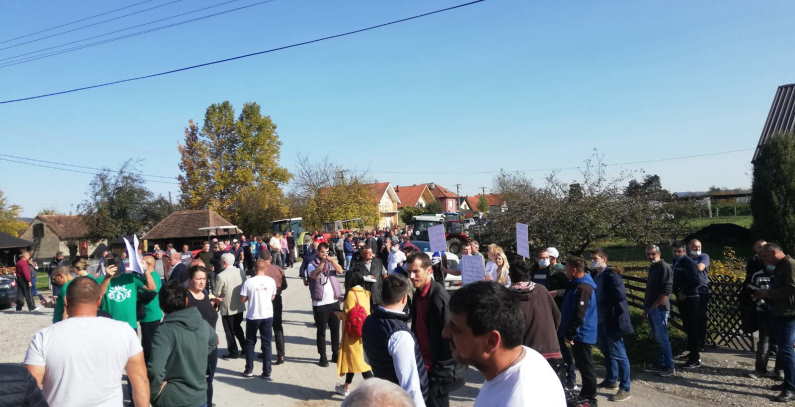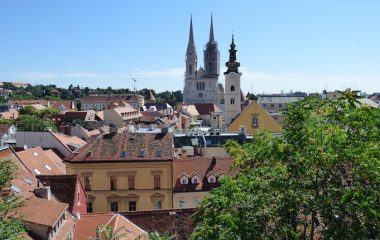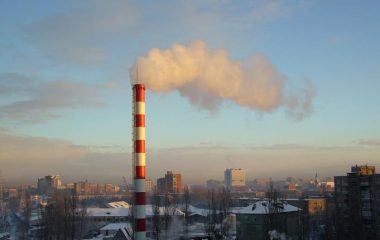
When the state has no control over the implementation of its own environmental protection laws, and investors are denying access to information about their projects or operations, then citizens – in this case Serbian citizens – are forced to take matters into their own hands and protect water, land, and air. This is precisely what is happening with the announced mining of jadarite, a lithium ore, in which global mining giant Rio Tinto could invest USD 1.5 billion. Is the state’s role to defend the investor at all costs or to protect its citizens? In recent days, this has been one of the most important questions in Serbia.
In the absence of answers about the proportions of the damage that jadarite mining could cause and what technologies will be applied, as well as whether they will have to leave their homes and why their agricultural land has been reclassified as construction land, residents of the Loznica area had no other choice but to band together in order to protect themselves.
They claim that the future jadarite mine, which will span some 500 hectares, will cause serious damage, not only to the areas around Krupanj, Loznica, and Valjevo, but to the entire country, because water and soil will be contaminated.
Locals claim that the mine will contaminate water and soil, while the prime minister insists it will revive the entire country
On the other hand, after years of silence, the British-Australian company, which has been exploring the jadarite deposit in Serbia for over 16 years now, and whose current market capitalization is USD 73 billion, says it will protect the environment as well as the local population.
The government is ignoring the questions about the Jadar project, but its representatives, including Prime Minister Ana Brnabić, are repeating over and over that this investment is an opportunity for Serbia’s economic revival and that the global demand for lithium is growing due to its use in batteries for electric and hybrid automobiles, which are the future of transportation.
What is the price of this revival in terms of environmental degradation? Nobody has answered this question yet.
One of the world’s biggest lithium deposits
According to Rio Tinto, Jadar is a world-class lithium-borate deposit, which was discovered in 2004. Two years later, the mineral was officially registered and named “jadarite” after the Jadar river, in whose valley it was discovered.
Due to high concentrations of lithium and boron, Jadar has been ranked as one of the most significant lithium deposits in the world, with declared mineral resources at 136
million tons.
The Jadar deposit, according to Rio Tinto, is located at the doorstep of the European automobile industry, which is quickly entering the era of electric vehicles in line with the EU’s green transport agenda.
People are left on their own

Marija Alimpić from the Protect Jadar and Rađevina association says that local residents are scared, but also angry.
“People are scared. On their estates, in the vicinity of their houses, there will be a disposal site for tailings from mining and processing, and there are also rumors that their land will be taken away from them unless they agree to sell it,” she said.
Hundreds of residents of the Loznica area expressed their dissatisfaction during a recent protest in the village of Brezjak, where Rio Sava Exploration, Rio Tinto’s subsidiary in Serbia, has an office.
Locals can already see the damage caused by Rio Tinto’s activities
People are upset because they do not have enough information and because they can see the damage caused by the company’s activities in their area, but also in other parts of the world.
In a situation where the state cannot protect them, they have started to join forces, registering the Protect Jadar and Rađevina association, with another similar organization soon to be founded.
Alimpić says that grass no longer grows around the exploration drill holes, and that some kind of liquid is leaking from protruding tubes.
“In the entire exploration area of some 500 hectares, there are underground lakes with potable water, which will be drained or contaminated in case of mining. Another consequence of exploration works, according to the locals, is the fact that water from a church well in the village of Gornje Nedeljice, just a few meters from the St George’s Church, has not been fit for drinking since 2018. All this unsettles people,” she says.
The destruction of a 46,000-year-old Aboriginal site
Due to the nature of their business, mining companies around the world are under constant public scrutiny. In September, Thinking Humanity reported that Rio Tinto had destroyed a 46,000-year-old Aboriginal site in Australia in order to expand an iron ore mine.
According to the website, the blame not only lies with Rio Tinto itself but also the Australian government, which has once again failed to stand up for the Aboriginal community.
When Serbian citizens look to the state, they see that Prime Minister Ana Brnabić regards Rio Tinto’s activities as a way to put Serbia on the world map, and its plans as something that could change the entire country, and for the better, in her view. The Serbian government and Rio Tinto have signed a memorandum of understanding, and they are now jointly looking for a partner who would open a factory to manufacture electric batteries or electric cars.
Agricultural land has been reclassified as construction land, increasing the tax burden on landowners
Rio Tinto’s considerable self-confidence is reflected in the price it is offering for the land. Zlatko Kokanović, a local farmer, says that the planned tailings disposal site will be 2,000 meters long and 500 meters wide, while its expected height is 40 meters. It would be located between two rivers, the Jadar and the Korenita, which occasionally spill over, raising fears that material from the tailings could end up in these two rivers, and then in the Drina, the Sava, and the Danube.
“They have offered us a price of EUR 102 per are (100 square meters), even though it is impossible to buy land in these parts – nobody is selling. Each plot of land is cultivated. Without land, and even with land that has a mine in the vicinity, there is no life for us here,” Kokanović said on a TV show.
Problems which are expected in this part of Serbia already exist in Bor, Požarevac, and Lazarevac
He added that the agricultural land in the area has recently been reclassified as construction land, without the owners’ knowledge. This entails a tenfold increase in taxes on this land, which can be interpreted as pressure on landowners to sell.
Zvezdan Kalmar of the Coalition for Sustainable Mining said at the protest in Brezjak that problems which are expected in this part of Serbia already exist in Bor, Požarevac, and Lazarevac. People there are already suffering, especially in Bor, he added. For this reason, according to him, the construction of the mine should be put on hold until serious environmental impact assessments have been completed.
The money the Serbian government intends to spend on the construction of a road, a power transmission line, a gas pipeline, and the supply of water from the Drina for this mine should instead be invested in these villages and agriculture, according to him.
Spatial plan adopted for the mining and processing project
According to Alimpić, a spatial plan for a special-purpose area for the jadarite mining and mineral processing project was adopted in February, following a public consultation. A report on the spatial plan’s strategic environmental assessment has also been prepared, and these are the only two official documents in connection with the project that are publicly available.
The plan is to cut nearly 200 hectares of forest
According to her, the plan covers 22 villages and 500 hectares of land. The mine is envisaged on the bank of the Korenita, a Jadar tributary, with underground mining to be performed underneath both rivers’ beds, she said. By the river, there will be a flotation facility which will use 1,000 tons of sulfuric acid, sodium hydroxide, and hydrochloric acid, she said.
As the tailings disposal site is expected to be located 20 kilometers from the river Štavica, between four villages, Dvorska, Krasava, Gornje Brezovice, and Cerova, the plan is to cut nearly 200 hectares of forest. According to the latest information, Rio Tinto is considering relocating the tailings site to a location in the vicinity of Paulje, an archeological site of exceptional importance, which is up to 3,500 years old.
Mixture of toxic chemicals will end up in the surrounding soil, water, or air
Alimpić noted that jadarite is a hydroxide sodium lithium borosilicate, and that a mixture of toxic chemicals is required to extract lithium.
Those chemicals, according to her, will end up in the surrounding soil, water, or air, while the adverse impacts of the mine could be felt up to 200 kilometers away.
She says the mine will be operated for about 20 years, and that it will leave ruined nature once it is closed.
The fertile Podrinje and Mačva will no longer be healthy soil for agriculture, or life
“The fertile Podrinje and Mačva will no longer be healthy soil for agriculture, or life,” she said. “How much does that pay off for Serbia given that all the ore will be the property of Rio Tinto?,” she asked.
Dragana Đorđević, a scientific adviser at the Institute of Chemistry, Technology and Metallurgy, who took part in the gathering, expects that the operation of this mine will have far-reaching and long-lasting consequences, while the damage caused will exceed the revenues from 4% mining royalty many times over.
According to her, the permanent destruction of agricultural land and water is not economically viable, given that water has recently started trading on global exchanges and that its price will rise dramatically going forward.
Finally, a word from Rio Tinto

Faced with growing discontent, Rio Tinto has decided to describe its activities.
The company says that about 2,100 jobs could be created at the peak of the mine construction phase, while over 650 highly-skilled workers will be employed full-time during the operation phase.
Jadarite will be processed using technology tested at a pilot plant in Australia
The Jadar project, according to Rio Tinto, has been in the feasibility phase since July this year. This phase entails completing technical documentation, obtaining permits, and buying land.
A final investment decision is expected at the end of 2021. If the decision is positive, the company expects that construction works could begin during 2022 and last about four years. The jadarite processing technology has been tested in a pilot plant at a research center in Australia, according to the company’s media release.
Concentrations of heavy metals in waste will be roughly equal to their concentrations in the soil
Rio Tinto said that it organizes “open door” events in Loznica and Brezjak on a regular basis, providing members of the local community with the opportunity to learn everything they want to know.
The government is looking for a partner to build a factory
Prime Minister Ana Brnabić said in February that the Serbian government and Rio Tinto are jointly looking for a strategic partner who would build a factory to manufacture electric batteries or electric automobiles in Loznica.
According to RTV, the third partner will use lithium to make a final product, which, according to her, will boost Serbia’s economy as a whole.
Rio Tinto says that it is still working on a detailed assessment of potential environmental impacts and that a comprehensive study will be completed during work on a feasibility study.
It is already known that a water treatment facility is planned to be built as part of the complex, in order to achieve the quality of water in line with applicable regulations, according to Rio Tinto.
The waste will be neither toxic nor hazardous
The mine and the processing plant will generate two types of waste: rock, from which jadarite will not be extracted, and industrial waste from processing. Both will be combined into one mass, which will be filtered and turned into cakes for disposal at the site.
Concentrations of heavy metals in the waste will be roughly equal to their concentrations in the soil. The waste will be neither toxic nor hazardous (flammable, erosive, volatile, etc.), the company said.
Rio Tinto also noted that it needs to buy some 250 hectares of land and that negotiations are under way with about 335 landowners. The land acquisition process, Rio Tinto added, is progressing in line with Serbian laws and the best global practices.









Be the first one to comment on this article.